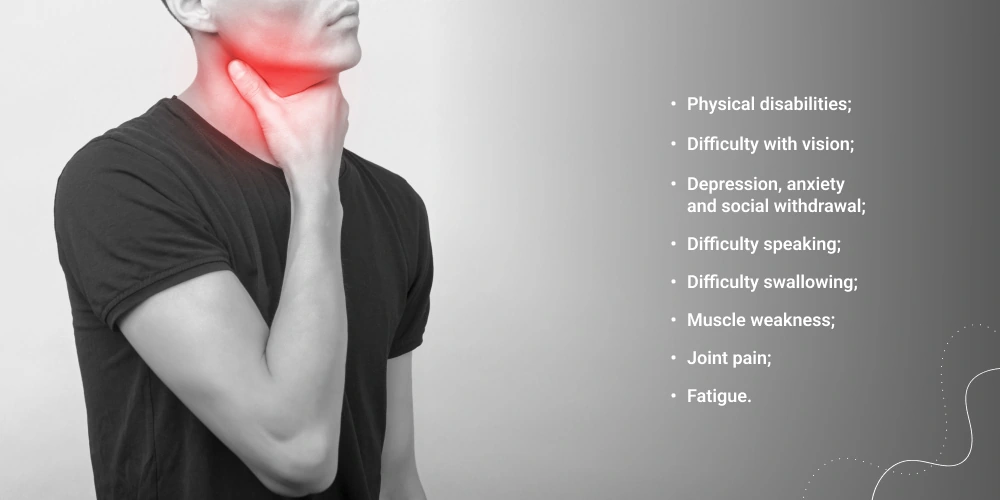Dystonia is a neurological ailment. It’s characterized by involuntary muscle flexions. It leads to twisting and repetitive movements or abnormal postures. While it predominantly affects adults, the illness can manifest in people of any age.
This article delves into the intricacies of the diagnosis of dystonia. And it explores the potential complications associated with this challenging condition.
Stay with us. Read the article to the end. And get all the necessary answers to questions about dystonia for your healthy life.
How to Diagnose Dystonia
Exploring the complexities of ailment detection necessitates a thorough and intricate assessment. The intricate process involves a multifaceted approach. There, physicians depend on a synthesis of:
- Medical records.
- Meticulous physical check-up.
- Cutting-edge tools.
This comprehensive diagnosis of dystonia is paramount for achieving an accurate assessment. By delving into a patient’s medical background, conducting detailed physical assessments, and leveraging advanced technologies, healthcare professionals can unravel the nuanced manifestations of ailment.
This approach not only enhances precision. It also facilitates tailored treatment strategies, promoting improved patient outcomes. In essence, the multifaceted nature of ailment necessitates a thorough examination, amalgamating various facets of medical expertise and technological advancements for an in-depth understanding and accurate identification of this ailment.
Genetic Testing
In cases where a familial history of ailment is present, a genetic dystonia test may help. Identifying genetic markers can provide valuable insights into the underlying causes. It aids in both assessment and treatment planning.
Medical Records
One of the primary steps in assessment involves gathering detailed medical records. Doctors inquire about the onset of signs, their progression, and any potential triggering factors. Understanding the overall health and any familial history of ailments is crucial. This is especially true in establishing a baseline for assessment.
Physical Examination
A thorough check-up is essential in the diagnosis of dystonia. It’s to observe and document the characteristic muscle flexions and abnormal postures. They’re associated with ailment. Neurologists often pay close attention to the distribution and pattern of muscle involvement. It helps them differentiate this ailment from other movement ailments.
Diagnostic Imaging
Advanced imaging techniques play a crucial role in the assessment of ailment. They’re magnetic resonance imaging (MRI) and computed tomography (CT) scans. These imaging modalities help rule out other potential causes of symptoms. Those are structural abnormalities or brain lesions.
Electromyography (EMG)
EMG is a procedure that measures the electrical activity of muscles. This dystonia test helps confirm the presence of an illness. It detects abnormal muscle flexions and patterns. EMG can also aid in differentiating this ailment from other neuromuscular ailments.
Blood Tests
Certain blood tests may be conducted. It’s to rule out metabolic or systemic conditions that could mimic ailment signs. These tests help ensure a comprehensive approach to assessment. And they guide physicians toward the most effective treatment strategies.
Dystonia Complications
Beyond the challenges of assessment, people often face a range of complications. They can significantly impact their quality of life. Understanding these potential complications is crucial for patients and healthcare professionals. It helps in developing comprehensive management strategies. The typical complications are:
- Functional Impairment. The impact of this ailment on daily functioning is profound. The involuntary flexions and abnormal postures can interfere with activities of daily living. They’re walking, writing, or even speaking. This functional impairment can lead to a reduced quality of life. And it increases dependence on others for basic tasks.
- Psychosocial Challenges. The visible nature of ailment signs can lead to psychosocial challenges. It includes stigma and social isolation. People may experience feelings of embarrassment or self-consciousness. It’s due to their abnormal movements, impacting their mental health and overall well-being.
- Chronic Pain. Chronic pain is a common dystonia complication. The sustained muscle flexions can cause discomfort and pain. It affects various parts of the body. Managing chronic pain in people with the ailment often requires a multidisciplinary approach. It involves medications, physical therapy, and psychological support.
- Secondary Musculoskeletal Issues. Prolonged muscle flexions can lead to secondary musculoskeletal issues. They’re joint contractures and skeletal deformities. These complications can further exacerbate functional limitations. And they require additional interventions, including orthopedic assessments and interventions.
- Speech and Swallowing Difficulties. The ailment can lead to significant communication and nutritional challenges. Speech therapy and dietary modifications may be necessary. It’s to address these dystonia complications and improve overall quality of life.
Rehabilitation and Supportive Therapies
The process and understanding of complications are crucial aspects. However, it’s equally important to highlight the role of rehabilitation and supportive therapies. They help enhance people’s overall well-being.
Rehabilitation programs play a pivotal role in addressing functional impairment and musculoskeletal issues. They include physical therapy and occupational therapy. They focus on improving mobility, strengthening muscles, and developing adaptive strategies. It’s to cope with daily challenges and dystonia complications.
Moreover, supportive therapies can significantly contribute to managing psychosocial challenges associated with illness. They are counseling and support groups. Providing a platform to share experiences, express concerns, and receive emotional support can help alleviate feelings of isolation and enhance mental well-being.
An integrative approach to ailment management should not only encompass accurate assessment and medical interventions but also emphasize the importance of rehabilitation and supportive therapies. Addressing both the physical and emotional aspects, doctors can work towards comprehensive care. It empowers people to navigate the complexities of living with an ailment.
Conclusion
The diagnosis of dystonia types requires a comprehensive approach. It integrates medical records, physical check-ups, and advanced tools. Genetic testing, imaging, electromyography, and blood tests are vital.
Also, people may face various complications. They range from functional impairment and pain to psychosocial challenges. Recognizing these complications is essential for healthcare professionals. It’s to tailor effective treatment plans that address both the physical and emotional issues.
Research continues to unravel the complexities of ailment. Advancements in techniques and therapeutic interventions offer hope for improved outcomes and a better quality of life for people grappling with this challenging ailment.
FAQ
What are the main challenges in diagnosing dystonia?
Diagnosing dystonia poses challenges. It’s due to:
- The variability in signs.
- Overlap with other disorders.
- Delayed recognition.
- The genetic complexity associated with some cases.
Are there any specific tests for diagnosing dystonia?
Yes, they’re EMG, MRI, CT scans, genetic testing, blood tests, and an examination by a neurologist.
Can dystonia lead to other health problems?
Yes, dystonia can lead to various health problems. It includes functional impairment, chronic pain psychosocial challenges, secondary musculoskeletal issues, and speech/swallowing difficulties. Managing these complications is essential. It’s for improving the quality of life for individuals with dystonia.
What treatment options are available for dystonia?
It includes medications, botulinum toxin injections, physical therapy, and, in some cases, surgery. The choice of treatment depends on the type and severity of dystonia. A neurologist or movement disorder specialist can help determine the most suitable approach.
Is dystonia a progressive condition?
Dystonia’s progression varies among individuals. Some may experience a stable or even improving condition. Others may see a gradual worsening of signs. Regular monitoring by healthcare professionals is crucial. It’s to adjust treatment plans and provide appropriate support as needed.













Please, leave your review
Write a comment: